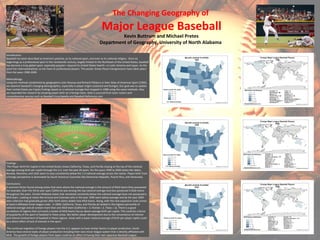
Aag Take 4
- 1. The Changing Geography of Major League Baseball Kevin Buttrum and Michael Pretes Department of Geography, University of North Alabama Introduction: Baseball has been described as America's pastime, as its national sport, and even as its national religion. Since its beginnings as a professional sport in the nineteenth century, largely limited to the Northeast of the United States, baseball has become a truly global sport, especially popular—beyond its United States hearth—in Latin America and Japan. As the sport has internationalized, so too have its professional players. This poster shows those transgressions have taken place from the years 1990-2009. Methodology: Using the methods established by geographers John Rooney and Richard Pillsbury in their Atlas of American Sport (1992), we examine baseball's changing demographics, especially in player origins (national and foreign). Our goal was to update their United States per Capita findings based on a national average that stopped in 1988 using the same methods. Also, we expanded the research by showing player birth on a foreign basis. Data is sourced from team rosters and comprehensive sources such as Baseball Encyclopedia and Baseball-Reference.com Findings : The Player birth Per Capita in the United States shows California, Texas, and Florida staying at the top of the national average among birth per capita through the U.S. over the past 30 years. For the years 1990 to 2000 states like Idaho, Nevada, Montana, and Utah seem to stay consistently below the 1.0 national average across the nation. Player birth from a foreign perspective is dominated by South American Countries like Dominican Republic, Puerto Rico, and Venezuela. Conclusions: A common factor found among states that were above the national average is the amount of MLB teams they possessed. For example, Over the thirty year span California was among the top national average and also possessed 4 MLB teams throughout the years. Certain Midwest states that remained constantly below the national average have not possessed a MLB team. Looking at states like Arizona and Colorado who in the year 1990 were below average and by the year 2000 data collection had gradually grown after both states added new MLB teams. Along, with the new expansion clubs comes at least 6 affiliated minor league clubs. In 2009, California, Texas, and Florida all ranked in the highest percentile of national average and all contain more than one MLB team (California = 3, Florida = 2, Texas = 2). There is a good correlation of regions that surround a cluster of MLB teams has an above average birth per capita. This could be a factor of popularity of the sport of baseball in these areas, like better player development due to the convenience of interest and intense involvement of baseball in these regions. Areas with a lower national average of birth per player capita could be a direct effect of lack of interest in the sport. The continual migration of foreign players into the U.S. appears to have similar factors in player production. South America have several styles of player production including their own minor league system that is directly affiliated with MLB. The growth of foreign players from Japan could be an affect of having their own Japanese Baseball League.